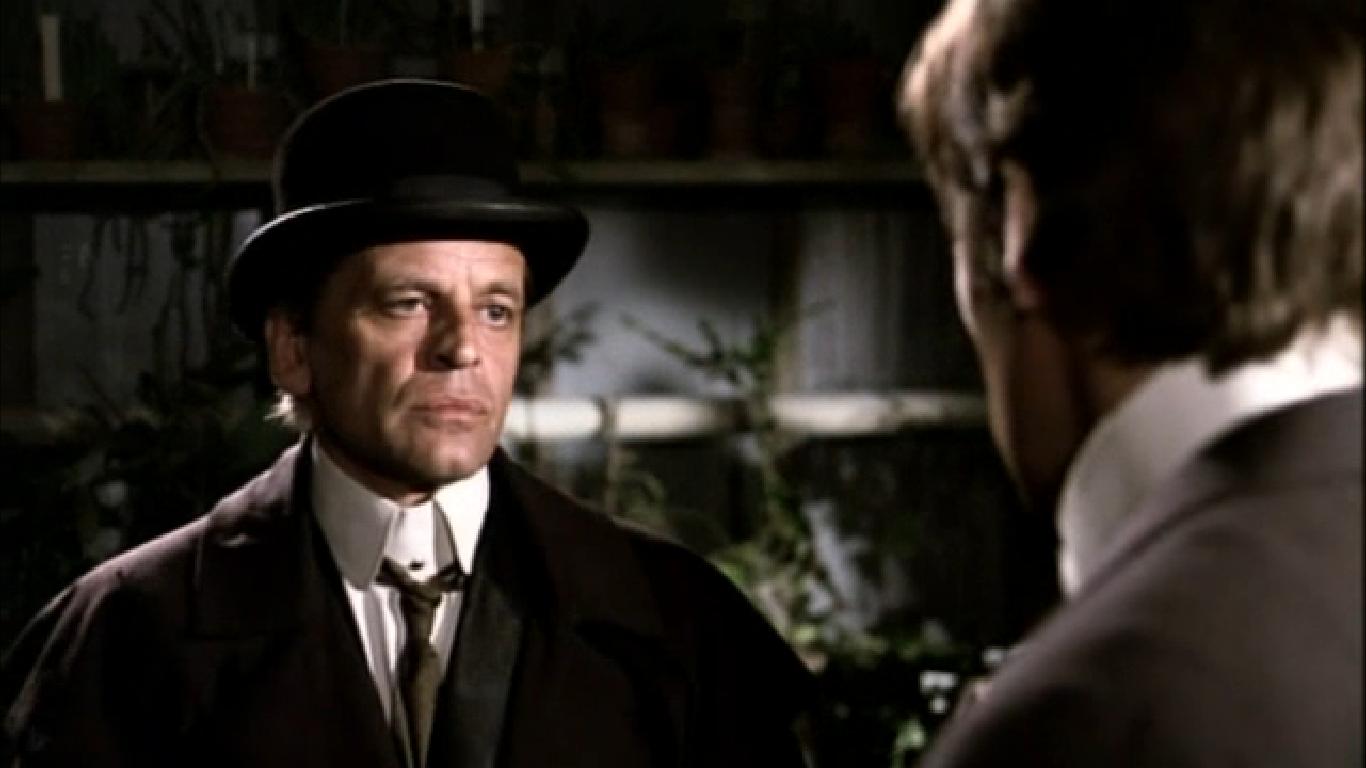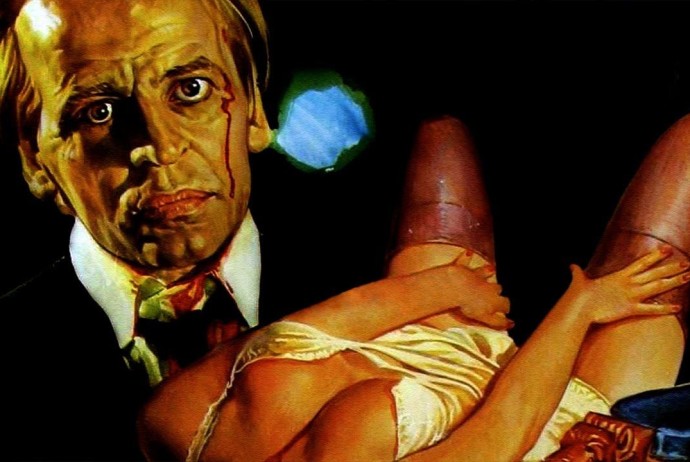Dir: Jess Franco
Star: Klaus Kinski, Andreas Mannkopff, Josephine Chaplin, Herbert Fux
The Jess Franco film so good I watched it twice? Well, kinda… It’s certainly better than most of Franco’s work – I’ve had my fair share of run-ins with the “tedious dreck” end of the spectrum in his filmography, but this is solidly workmanlike, and grounded mostly in Kinski’s fine performance as the central character. However, the double viewing is less because of any quality, than the first copy I got was the English-language version which is among the worst dubs I’ve ever had the misfortune to experience. Virtually none of the characters sound anything like their characters; they could have had Betty Boop dub Kinski, and it would have been more appropriate. That necessitated getting hold of the original German version, which is (as usual) a great deal better.
Just do not expect anything like authenticity, or anything bearing much more than a tangential relationship to the real Jack the Ripper, despite a couple of nods, which I’ll get to later. That’s clear right from the start, where a lady of the night is warned outside the enchantingly-named Pike’s Hole music-hall: “You have to walk through Kensington and Chelsea, where he looks for his victims.” Er… No? And Zurich isn’t much of a substitute for London either, despite providing some waterways through which bodies can be transported. Still, as long as you’re happy with lurid sleaze, you’ll find plenty to enjoy here, even if it does fall a little short of Edge of Sanity, another take on the tale from a sometime director of porn, Gerard Kikoine. That had Anthony Perkins, threw a large helping of Dr. Jekyll and Mister Hyde into the blender, and was shot like the demented offspring of Ken Russell and Dario Argento. Compared to that masterpiece of misbegotten excess, this is almost tame, yet there’s a good amount to appreciate.
The story has Kinski playing Dr. Orloff, a character name used a bunch of other times by Franco, from 1962’s The Awful Dr. Orloff through to one of the director’s best, Faceless, in 1987. He has what can only be described as severe mommy issues, and is acting these out by abducting prostitutes and dismembering them, with the help of an assistant, Frieda, who may be mentally deficient and/or in love with Orloff [the film is vague on such details]. It’s never clear if Orloff’s recollections of his mother as a whore are literal or metaphorical, but if the former, it doesn’t appear to have prevented him from rising up to pursue a medical career, As the body count rises, Inspector Selby (Mannkopff) of Scotland Yard investigates the case, but matters are complicated by his ballet-dancer girlfriend, Cynthia (Chaplin – the daughter of Charlie!), who decides to go undercover in search of the killer herself. Needless to say, she finds the not-so good Doctor, only to fall into his clutches as Selby searches frantically for both of them – like a number of others, a plotline also largely recycled from The Awful Dr. Orloff.
 It’s certainly an epic bit of casting to have Kinski playing a largely undiluted sexual psychopath, and he is actually quite restrained in his performance, save for a couple of moments where the mommy issues burst out in a gush of scenery-chewing. There’s no doubt Kinski had an ambivalent attitude towards women, and it’s the nastier side which is allowed full rein here, in his brutal treatment of his victims, usually raping them before beginning their dismemberment, which is depicted in occasionally highly graphic fashion. The worst such is reserved for frequent Franco muse (and future wife), Lina Romay, whose promising career as a music-hall act is brought to an abrupt end by Orloff carving off one of her breasts in its entirety. Yet Orloff spends his days tending to the poor, accepting whatever they can pay. It’s an unusual dichotomy, perhaps intended to expose Victorian hypocrisy [though when one of his patients attempts to blackmail the doctor, the results are unsurprising!].
It’s certainly an epic bit of casting to have Kinski playing a largely undiluted sexual psychopath, and he is actually quite restrained in his performance, save for a couple of moments where the mommy issues burst out in a gush of scenery-chewing. There’s no doubt Kinski had an ambivalent attitude towards women, and it’s the nastier side which is allowed full rein here, in his brutal treatment of his victims, usually raping them before beginning their dismemberment, which is depicted in occasionally highly graphic fashion. The worst such is reserved for frequent Franco muse (and future wife), Lina Romay, whose promising career as a music-hall act is brought to an abrupt end by Orloff carving off one of her breasts in its entirety. Yet Orloff spends his days tending to the poor, accepting whatever they can pay. It’s an unusual dichotomy, perhaps intended to expose Victorian hypocrisy [though when one of his patients attempts to blackmail the doctor, the results are unsurprising!].
I kept expecting Mrs. Baxter, Orloff’s landlady, to play a significant role in proceedings; that doesn’t happen, and her character serves no real purpose. On the other hand, I was quite impressed by the police procedural aspects, in particular a scene where the Inspector has to wrangle witnesses of wildly varied social stature into putting together a composite portrait, only to find there are two, clearly different descriptions. Fortunately, the sharpest tool in the box is also present, in the shape of a blind man, whose heightened senses provide a couple of key elements that narrow down the inquiry, and also gives Selby a crucial clue after Cynthia is abducted. However, the ending falls kinda flat: rather than any kind of fitting retribution for or by society, on behalf of the numerous victims, Orloff simply gives himself up, though in response to Selby’s assertion, “You are Jack the Ripper,” the doctor counters coolly, “You will have to prove that first.”
There are occasional, albeit slight, nods to real Ripperology. For there is some evidence to suspect the real Ripper may, like Orloff, have had medical training, and the film does make a reference to him having “relatives at Buckingham Palace”, perhaps hinting at the connection to the British royal family which has been suggested by some. However, this is an entity appreciated for its own merits, whatever they might be, and not as any kind of historical reconstruction. In particular, it’s good to see a Kinski film which truly lives up to that label, with him front, center and given the opportunity to unleash, quite possibly, a few of his own inner demons involving sex and death. As so often, however, you are left to wonder what might have been, had the material been handled by a better director than Franco, though the results here are certainly among the upper tier of his filmography. Just don’t inflict the dubbed version on youself, for that would be far more horrible than any of the breast-removing and repeated stabbings carried out on Orloff’s victims!
